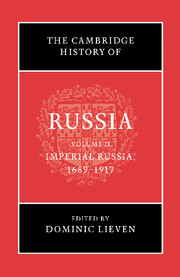Book contents
- Frontmatter
- Introduction
- Part I Empire
- Part II Culture, Ideas, Identities
- Part III Non-Russian Nationalities
- Part IV Russian Society, Law and Economy
- 11 The elites
- 12 The groups between: raznochintsy, intelligentsia, professionals
- 13 Nizhnii Novgorod in the nineteenth century: portrait of a city
- 14 Russian Orthodoxy: Church, people and politics in Imperial Russia
- 15 Women, the family and public life
- 16 Gender and the legal order in Imperial Russia
- 17 Law, the judicial system and the legal profession
- 18 Peasants and agriculture
- 19 The Russian economy and banking system
- Part V Government
- Part VI Foreign Policy and the Armed Forces
- Part VII Reform, War and Revolution
- Bibliography
- Index
- Map 5. The Russian Empire (1913). From Archie Brown, Michael Kaser, and G. S. Smith (eds.) Cambridge Encyclopedia of Russia 1982.">
- Plate Section">
- References
18 - Peasants and agriculture
from Part IV - Russian Society, Law and Economy
Published online by Cambridge University Press: 28 March 2008
- Frontmatter
- Introduction
- Part I Empire
- Part II Culture, Ideas, Identities
- Part III Non-Russian Nationalities
- Part IV Russian Society, Law and Economy
- 11 The elites
- 12 The groups between: raznochintsy, intelligentsia, professionals
- 13 Nizhnii Novgorod in the nineteenth century: portrait of a city
- 14 Russian Orthodoxy: Church, people and politics in Imperial Russia
- 15 Women, the family and public life
- 16 Gender and the legal order in Imperial Russia
- 17 Law, the judicial system and the legal profession
- 18 Peasants and agriculture
- 19 The Russian economy and banking system
- Part V Government
- Part VI Foreign Policy and the Armed Forces
- Part VII Reform, War and Revolution
- Bibliography
- Index
- Map 5. The Russian Empire (1913). From Archie Brown, Michael Kaser, and G. S. Smith (eds.) Cambridge Encyclopedia of Russia 1982.">
- Plate Section">
- References
Summary
Imperial Russia had an overwhelmingly peasant population and its economy was largely agricultural. The Russian Empire was not able to compete economically and militarily with the more ‘developed’ states of north-western Europe, North America and Japan in the last few decades of its existence. Over the preceding two or three centuries, however, Russia’s autocratic state had been able successfully to exploit its peasant population and agricultural economy to generate the resources, in particular tax revenues and military conscripts, to consolidate and maintain its power at home and build a vast empire that came to dominate eastern Europe and northern Asia. Imperial Russia’s peasants were, thus, at the bottom of an exploitative social order. For much of the period, moreover, between a third and a half were the serfs of noble landowners in a system of bonded labour that emerged in the late sixteenth century and lasted until its abolition in 1861. Most of the rest of the peasantry lived on state lands and were subjected to slightly less onerous restrictions and demands. The subordinate and exploited status of all Imperial Russia’s peasants is one of the wider contexts in which their ways of life can be examined. Another wider context is the natural environment in which they lived and worked. In the northern half of Russia, which was covered in forests, the soils were not very fertile, and the winters long and cold. In the southern half, in contrast, the black earth of the steppes was very fertile, the climate warmer, but the rainfall was low and unreliable.
- Type
- Chapter
- Information
- The Cambridge History of Russia , pp. 369 - 393Publisher: Cambridge University PressPrint publication year: 2006
References
- 6
- Cited by



